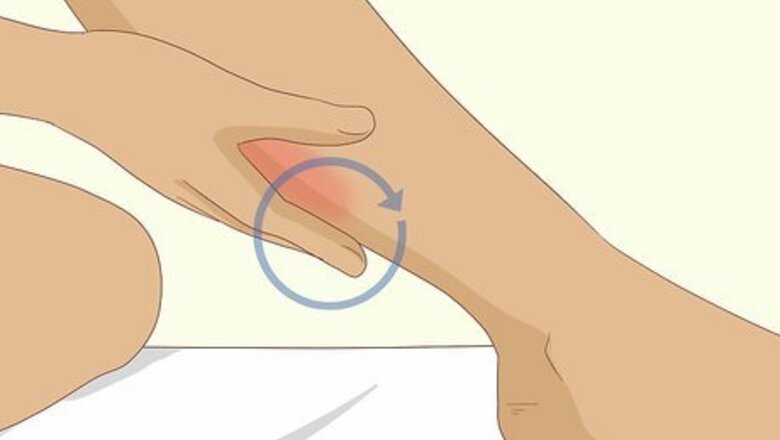
views
- Massage the cramping area with your fingers for 3-4 minutes, using firm but gentle pressure and working in small circles all around the muscle.
- Stretch the cramping muscle for 1-2 minutes. Sit up in bed with your legs in front of you, then reach forward and pull your toes toward you.
- Prevent Charley horses by stretching frequently, drinking 12–15 cups (2.8–3.5 L) of water a day, and eating foods rich in potassium, like bananas.
Treating a Charley Horse
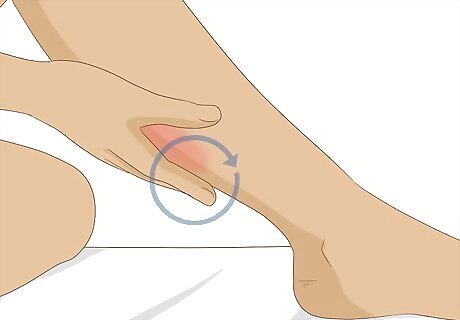
Massage your muscles with your hands for 3-4 minutes. Massaging the cramp provides the most immediate and reliable relief. Use your fingertips or knuckles to gently but firmly massage the problem area in circular motions. Also massage the area just above the cramp to help improve circulation, which may get rid of the cramp faster. For added relief, use an ice pack to massage the cramp instead of your fingers. The cool temperature helps to soothe the spasming muscles. Use a massage roller to help you apply more even and thorough pressure than you might achieve with your hands alone.
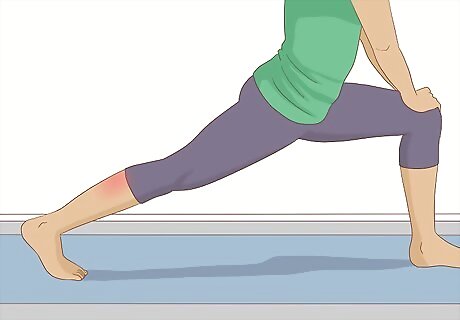
Stretch the cramped area and keep it taut for 1-2 minutes. During a cramp, your muscles become constricted as a result of spasms. Stretching the muscles helps to relax and soften them. It may be a little uncomfortable, but it’s a quick and reliable way to work out your Charley horse. Perform one of the following stretches, or a combination of the three: For calf cramps: Get into a lunge position, with your cramping leg extended straight behind you. Bend your other leg, stretching your cramped calf muscles as much as you’re able. Or, stand straight and on your toes and hold that position for as long as you can manage, repeating until the cramp subsides. For front-of-thigh cramps: Stand up straight and pull the foot of your cramping leg behind you and toward your buttocks. Use a chair to steady yourself. For foot cramps: Sit up straight and place your legs straight out in front of you. Lock your knees and point your toes back towards your face. Grab your toes and gently pull the cramping foot back toward you.
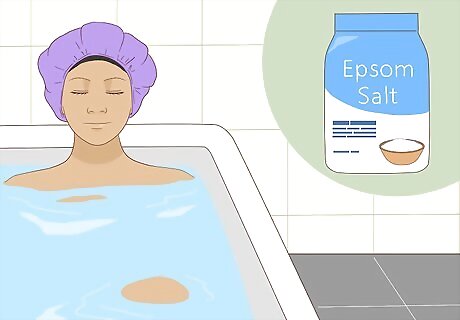
Take a hot shower or a bath with Epsom salts. The heat from a warm shower or a bath may help to alleviate discomfort caused by cramps. If you’re taking a shower, direct the water onto your cramp for 30-60 seconds at a time, until the cramp resolves. If you’re taking a bath, add 1-2 cups (300-600 g) of Epsom salt and soak for 10-20 minutes. Epsom salt contains the compound magnesium sulfate, which may increase your magnesium levels, helping to alleviate cramp pains.
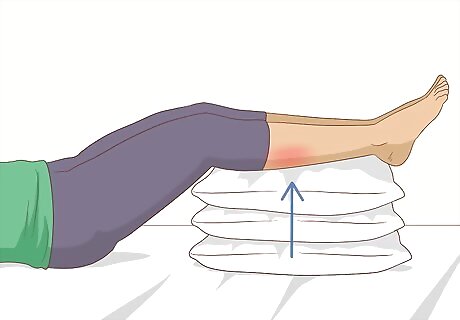
Elevate the area until the cramp goes away. Raise the affected area by propping it up on pillows or the armrest of a chair or couch. Elevating the area helps to improve your circulation and move blood to and from the spasming area more effectively, clearing the cramp. Combine this treatment with massaging or stretching to make it more effective.
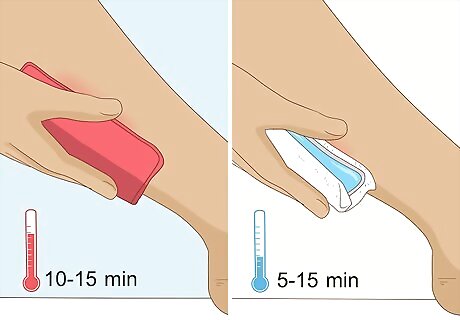
Apply heat followed by ice to ease the pain. To calm down the muscle spasms, use a hot compress or a heating pad for 10-15 minutes to relax the muscles. Then, immediately apply an ice pack or cold compress to the cramping area. Never apply ice directly, but wrap it in a towel or bandage before placing it on your skin. Do this for 5-15 minutes for the best results. To make a hot compress, soak a washcloth or a small towel with hot water, then wrap it around the cramping area, applying pressure with your hands.
Preventing Future Charley Horses
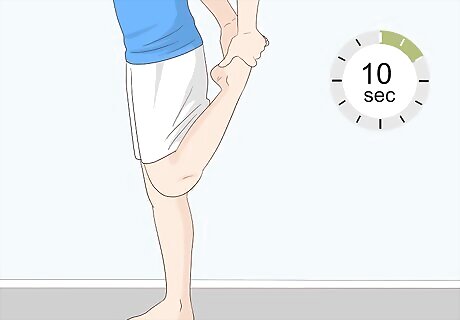
Stretch your legs immediately before you exercise or sleep. If you exercise regularly, stretch before and after your workout to prevent leg cramps later. Even if you don’t exercise, stretch for 3-4 minutes before bed to help avoid Charley horses at night. Stretching helps to loosen and relax your muscles, which makes them less likely to tighten and cause cramps. Perform a quad stretch by grabbing your foot behind you and holding it to your buttock for 10 seconds. Then, repeat the stretch on the other leg. To do a lunge, get in a kneeling position on the ground so that one leg is bent at the knee and you are resting completely on the other calf. Then, raise yourself off the ground so that both of your legs are bent. Do multiple lunges by walking around the room in that position, going back and forth between legs.
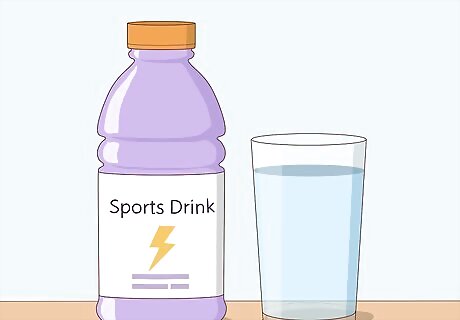
Stay hydrated throughout the day to keep cramps at bay. When sodium levels in your blood are high, it affects your muscles and circulation. Keep your sodium levels low and your muscles relaxed by drinking plenty of water on a regular basis. When you’re working out, supplement your intake of water with sports drinks that have added electrolytes. Aim to drink about 12–15 cups (2,800–3,500 mL) of water each day. Also, limit your alcohol and caffeine intake, both of which tend to dehydrate your body. A cup of coffee in the morning is fine, but think twice before that second or third cup. Some say that drinking pickle juice also gives your body much-needed electrolytes. While pickle juice has been shown to be effective at relieving cramps, it’s most likely because the taste “distracts” your brain from the cramp, shutting off the neuron activity that causes cramps. The more you know!
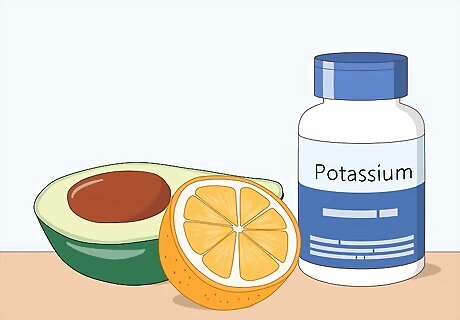
Consume about 4,700 mg of potassium each day. Low potassium levels are related to an increased likelihood of muscle spasms and cramps. Eat potassium-rich foods like bananas, avocados, and oranges at least once a day, or take potassium supplements as directed by your doctor or by the instructions on the supplement packaging. Other potassium-rich foods include spinach, sweet potatoes, and cantaloupe.
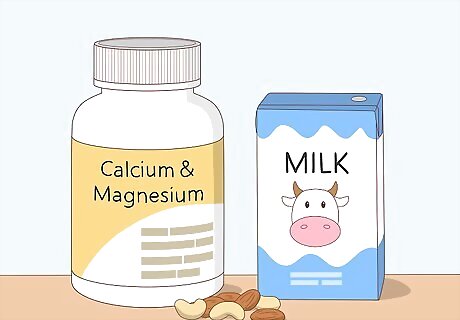
Consume more calcium and magnesium. These vitamins work hand in hand to prevent muscle cramps and keep your body in tip-top shape. Doctors recommend getting about 1,000 mg of calcium per day. Adults should also aim to get about 200-400 mg of magnesium each day. Dairy products and nuts are full of both these minerals. Also consider taking mineral supplements to reduce cramps, but talk to your healthcare provider to find a dosage that’s right for you.
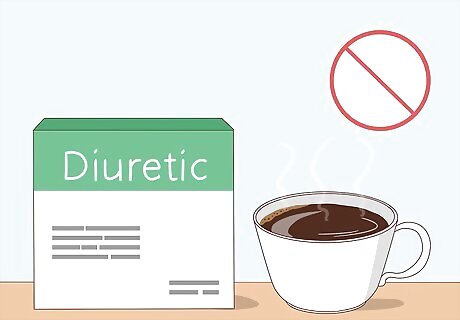
Avoid diuretics to stay hydrated. Almost anything that causes you to urinate more (save for water) will reduce the amount of water and electrolytes in your body, which is a recipe for muscle cramps. Avoid drinking too much caffeine, laxatives, or pills that cause frequent urination whenever possible. If you take a diuretic prescription medication, talk to your doctor about how it may be causing cramps. They may alter your dosage or prescribe supplemental treatment.
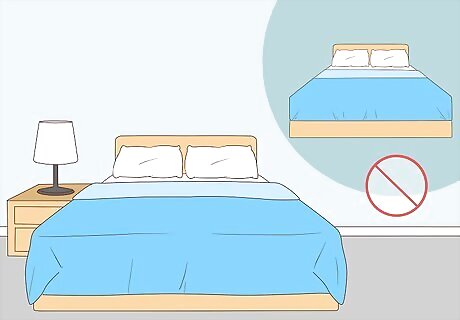
Loosen the sheets around the edges of your bed. You sometimes get Charley horses when your feet or legs struggle against the pressure of tight or heavy sheets or blankets, stressing your muscles and leading to cramps. Untuck your sheets or sleep with your feet outside of your blanket to help prevent night time pains. Also, sleep on your left side, which reduces pressure on your liver, increasing blood flow.
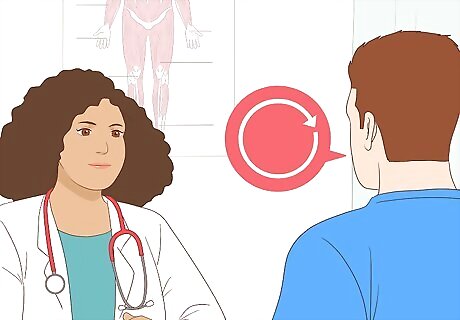
See your healthcare provider if your cramps are chronic or severe. Intense or frequent leg cramps may be caused by an undiagnosed health condition, so talk to your doctor about your cramps if they cause you significant distress. If your cramps are accompanied by numbness or severe weakness, make an appointment ASAP to help you restore mobility. Frequent leg cramps may be associated with diseases or problems with the spine, liver, or blood vessels.
What causes Charley horses?
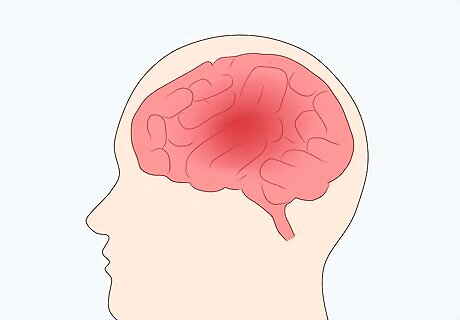
Leg cramps are often caused by reactive neurons in your brain. Researchers are still studying what makes your muscles act up, but recent studies show that your brain may be to blame. As your muscles fatigue, nerve receptors in your muscles send signals to the brain, which in turn commands the muscle to contract, causing cramps or Charley horses. At the same time, your brain sends signals that prevent relaxation. That’s why it’s important to massage or stretch your muscles to manually override this brain signal. Sometimes, these cramps seem to happen for no reason at all. These are called “idiomatic” cramps, and are typically the cause of your Charley horse.
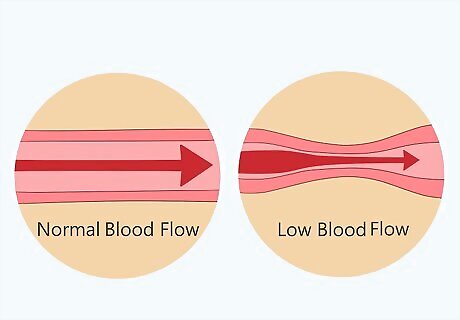
Cramps might also be caused by low blood flow or nerve compression. When your arteries narrow because of dehydration, the muscles in your legs may respond by tightening, causing cramps. In addition, too much pressure on the nerves in your spine may cause muscle tightening in your legs. That’s why hydration, mineral intake, and physical exercise are important to preventing cramps, since these increase blood flow and relax your muscles. Certain medications may also be to blame for your frequent cramps. Talk to your doctor about your prescription regimen, and if any of your prescriptions may be causing your Charley horses.
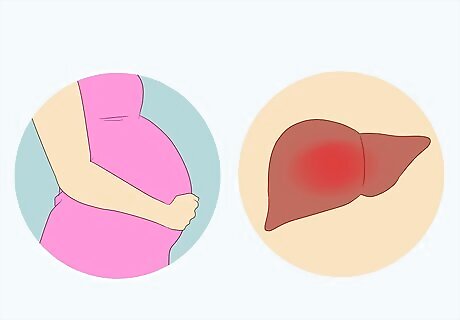
Cramps are also associated with age, pregnancy, or medical issues. As we get older, we tend to lose muscle mass, which stresses our muscles more easily and leads to more frequent cramps. Pregnant people also experience more cramps as their bodies grow and change. In addition, medical conditions like diabetes or nerve or liver diseases may interfere with blood flow, leading to those unwelcome Charley horses late at night.




















Comments
0 comment